Tattoos are now common but they have been around for at least 5,200 years. It is not very surprising to see someone with a heart or a quote tattooed on their body. Our perception of tattoos is very closely associated with western pop culture. But tattoos have a remarkably diverse and long past. Different cultures across the world have embraced tattoos as a significant part of their traditions. These traditions have a unique implication for each community. In some cultures, tattoos have been taboo too. The world of tattoos needs to be explored and understood better.
The word tattoo had originated from the Polynesian word ‘tatau’. After his first travel to New Zealand and Tahiti in 1771, Captain James Cook brought this word to Europe. He had seen there, men and women with huge tattoos all over their bodies. His fascination for their ‘tatau’ came back to the western world with him. But unlike the origin of this word, the art of tattooing is not a recent phenomenon. As mentioned above, tattoos are at least 5,200 years old. The earliest evidence of tattoos had been discovered on the mummified remains of Ötzi the Iceman. Discovered in the Oztal Alps in 1991, he had about 61 tattoos. Most of them were around his lower back and joints. There have also been discoveries of tattooed mummies in countries like Egypt, Sudan, and the Philippines.
Different countries and cultures have perceived tattoos in their own ways. Some of the most distinct and popular systems are:
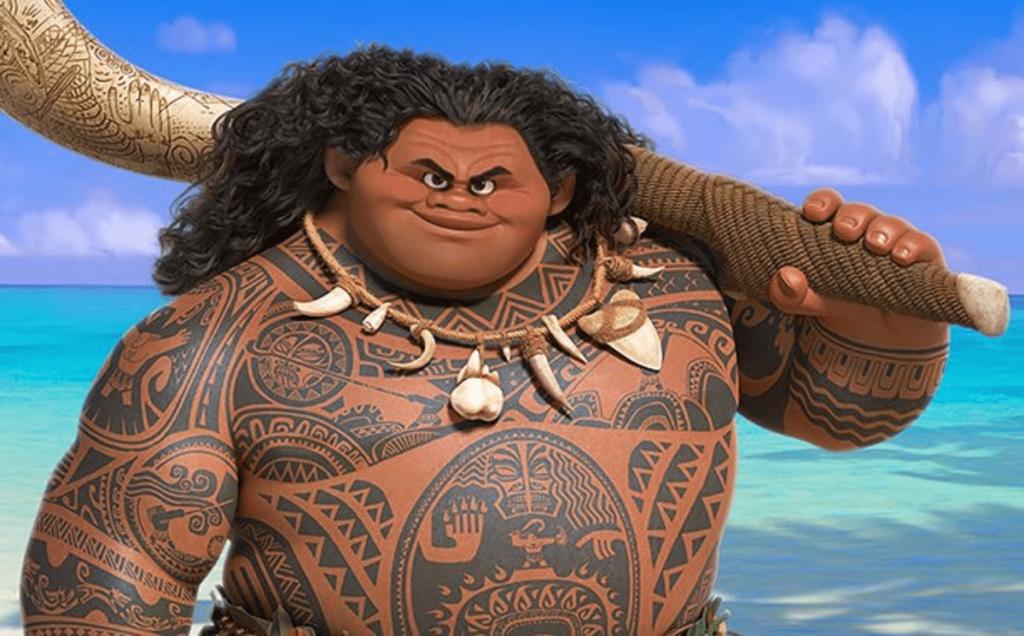
Maui’s tattoos inspired by Maori culture, Source: Disney’s Moana
Native to New Zealand, the Maori tribe has a rich culture of tattooing. It reflects a sense of pride, belonging, and identity. Their style is also very different from their Polynesian neighbors. In fact, contrary to conventional belief, not having tattoos is a rebellious act in the Maori tradition. Tattoos are considered sacred, representing a rite of passage for both men and women. Every design and symbol has a special meaning. Tattoos symbolize aspects like personal growth, ancestry, rank, individuality, life history, and achievements. The Maori tribe considers the face to be the most important and sacred part of the body. The Ta Moko represents the art of face tattoos. While men tattoo their whole faces, women tattoo their chin, lips, nostrils, and throat only. A woman’s chin tattoo is known as Moko Kuaue. Tattooing on any other part of the body is referred to as Kiri Tuhi. For boys and girls, getting tattooed would represent the transition to adulthood. Soldiers would often get tattoos to appear more dangerous to their enemies. Tattoos are also considered a beauty symbol, making the person more attractive. Getting Maori tattoos is a painful process. To make these tattoos, the tattoo artists puncture the skin using chisels. The whole process renders the person bedridden for days. This art suffered immensely under the colonial suppression of the 20th century. The 1970s witnessed a revival and restoration of this sacred tradition. Maori tattoos continue to hold the same essence and standing to date. For Maoris, tattoos will always be a precious taonga (treasure).
Maori Tattoo Patterns: The main outlines in the Maori tattoos, known as Manua, translates to ‘heart’. These lines represent a journey through life, achievements, and aspirations. Korus are spirals that represent aspects like harmony, growth, new beginnings, and loved ones. There are many other symbols like the Hei Matau (prosperity, good health), Pikorua (path of life, eternity), and Hei-tiki (ancestry).
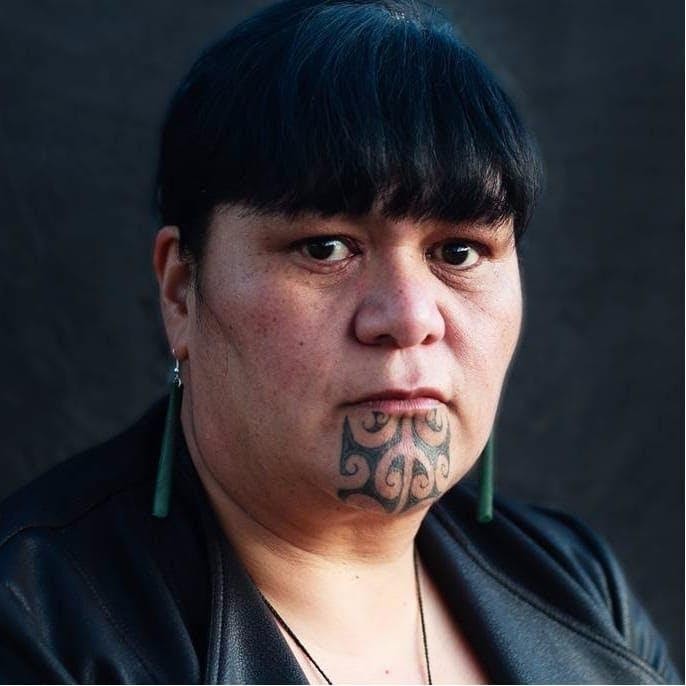
Nanaia Mahuta, the first parliamentarian to wear a Moko Kuaue
Photo: Kina Sai
-A verse from a traditional tattoo artist’s song
Samoan or Polynesian tattoo culture has a legacy that dates back at least 2,000 years. Almost every individual in the community bears tattoos on their bodies. Tattoos are not seen merely as a body embellishment. They also represent a person’s position in society and their ancestry. It is a symbol of honor, strength, and virtue for Samoan culture. Warriors and chiefs tend to have the most extensive tattoo work. Male tattooing is known as Pe’a. Traditional Samoan males get tattooed from mid-torso to the knees with intricate designs. Women have tattoos that start from below the knees and go up to the upper thighs. Their tattoo style is known as Malu and is more delicate compared to Pe’a. The tattoo artists, known as tufuga, use tools made of sharpened boar teeth, turtle shells, and wood. The whole process is long and painful. There is also a risk of infection. After the work was complete, the tattoos would take a while to heal. The whole tribe would assist the person in his daily affairs until he was fit to do so himself. Despite the dangers, a man was called a coward if he did not go through the process. A ceremony would celebrate the end of this difficult yet fulfilling journey. The coming of Christian missionaries in the 19th century was a setback to this custom. Tattoos were seen as barbaric, and they tried to eradicate it. Samoan tattoo culture has managed to survive through this intrusion.
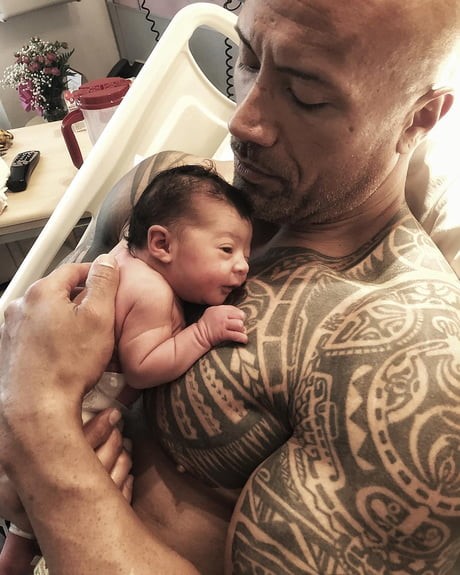
Dwayne ‘The Rock’ Johnson’s Samoan Tattoo – A tribute to his homeland
Via: @therock Instagram
Patterns: The symbols are based on the four elements- the ocean, earth, fire, and wind. Some of the commonly used symbols are Tiki (protection), turtle (fertility), dolphin (wisdom), Shark teeth (power, ferocity), and sun (brilliance, leadership).
Many Egyptians consider tattoos as a taboo in contemporary times. This has mostly to do with the present-day religious restrictions and government opposition in the country.
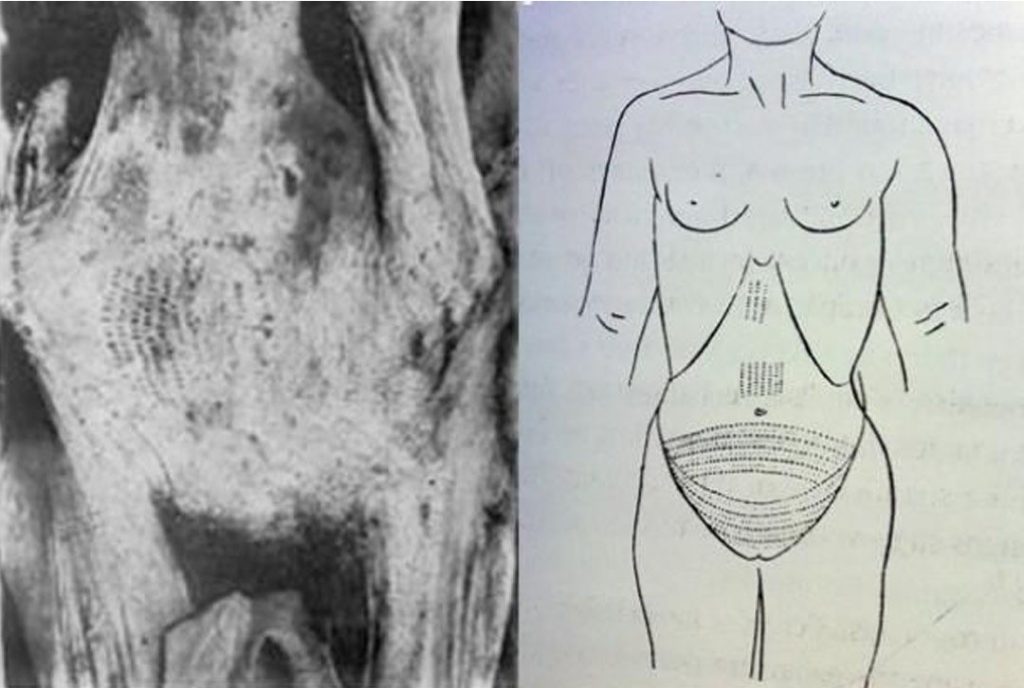
Tattooed dots found on the abdomen of female Mummies
Via: tattoo.com
Patterns: Some of the most well-known symbols are: lotus flowers (life and rebirth), scarab beetle (mound of creation), the Ankh (key of life, a symbol of river Nile), cows (associated with goddess Hathor), Eye of Ra (restoring harmony), Egyptian Gods, etc.
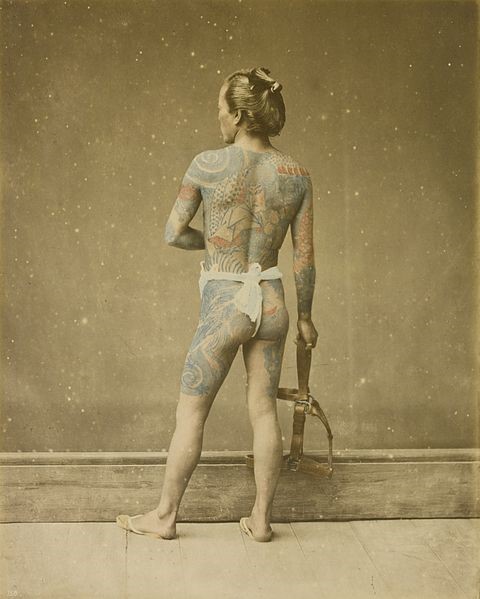
Traditional Irezumi
Tattoos in Japan have had a very complicated history. Known as Irezumi, the Japanese art of tattooing can be traced back to the Jomon period (14,500 BC – 300 BC). Clay figurines called ‘dogus’ belonging to this era have been recovered with tattoo-like marks. According to Chinese records dating back to the 3rd century, Japanese men from different tribes bore many tattoos on their faces and bodies. This ancient art form held different meanings – as a decorative body art, representation of spiritual and religious beliefs, as well as a status symbol that varied with rank. The relevance of tattoos has fluctuated in the Japanese society since then. By 720 AD, forehead tattoos explicitly became a device of criminal punishment. The Edo Period (1603-1868) then brought about the golden age of tattooing. The growth of woodblock printing, known as ukiyo-e had popularised folklore heroes. Their images were now being tattooed on bodies. It is during this phase that Irezumi flourished and grew as an art. Irezumi tattooing is a long and painful process. The traditional technique of tattooing by hand is tebori. They use chisels and gouges, which are needles bound to a metal or a wooden stick. They also use a special type of ink known as Nara Ink. The rulers tried to ban tattoos around this time. The Japanese government reused tattoos as a form of punishment, known as bokkeii. Prisoners would be branded with tattoos, making it difficult for them to re-enter society. The Yakuza, a criminal gang, started using full-body tattoos as a symbol of protest. It soon became a rite of passage for every new member. Ultimately, the government outlawed tattooing. It was legalized only after the American occupation in 1948. By then, a stigma around tattoos had already settled in the society. Even now, tattoos are looked down upon. Several public places, like saunas, gyms, and pools, have a strict no-tattoo policy.
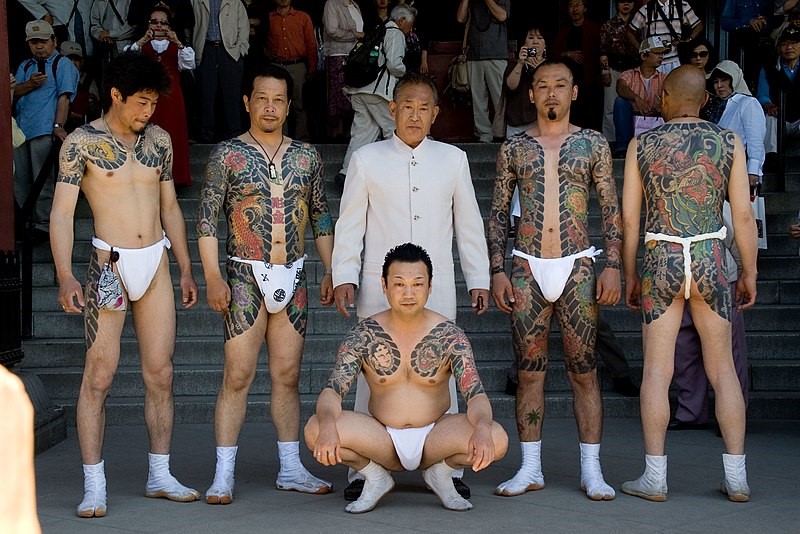
The Yakuza
Patterns: Some of the most popular motifs are Koi fish (luck, good fortune), sakura or cherry blossoms (transience), Ryu or dragon (wisdom, patience, creativity), tiger (strength, ferocity, protection).
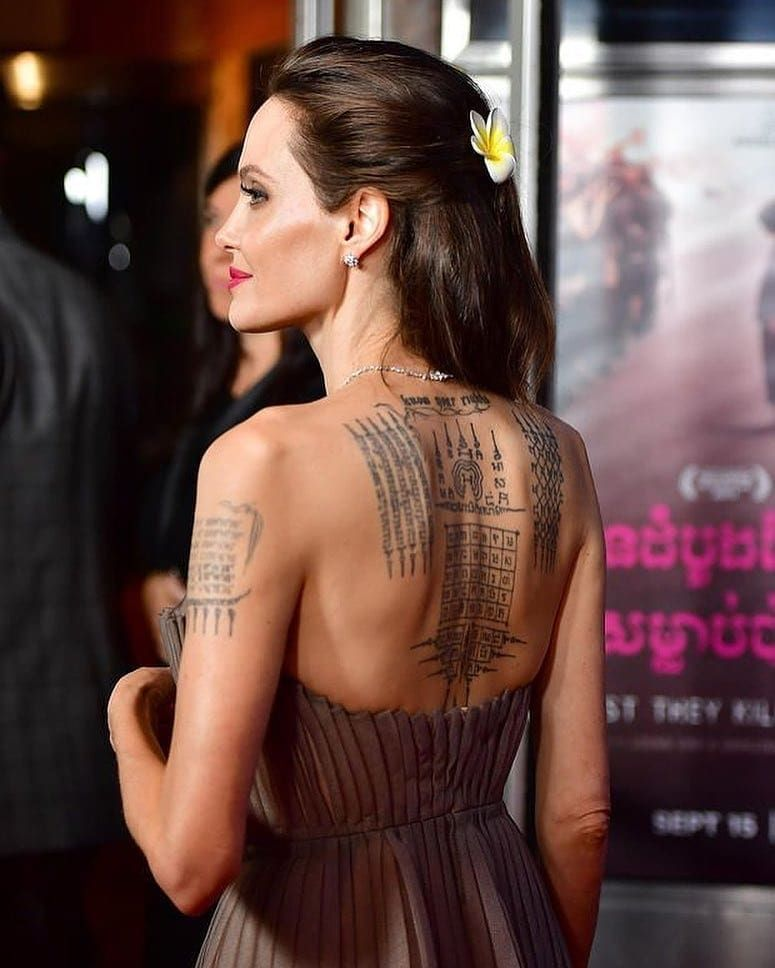
Angelina Jolie’s Sak Yant Tattoos
Via: thestyleup.com
The traditional Thai art of tattooing is known as Sak Yant. Literally, ‘Sak’ means ‘to tap’ or ‘to tattoo’, while Yant comes from the Sanskrit word ‘Yantra’ which refers to a machine/apparatus. The intricate geometric designs make the tattoos look aesthetic. Such tattoos are seen as no ordinary creations. The symbols, prayers, and scriptures that are tattooed carry a religious and spiritual message. These tattoos are believed to be magical and sacred. Only monks and ajarns who undergo rigorous training to learn this sacred art can create these tattoos. Sak Yant tattoos had originated from the Khmer people. Asian religions, especially Buddhism and Hinduism, have moulded this tradition over time. Each work holds a special meaning that is unique to the wearer. It is a holy belief that these tattoos would bring them luck, strength, and healing and protective powers. Warriors would often get Sak Yant tattoos for strength and protection against their enemies. The Sak Yant Master chants a final blessing to activate the magical powers of the tattoo. The traditional style of stick-poke tattooing is still prevalent in this tattoo culture. They use a metal or a bamboo stick with a needle attached to the top. The ink is a mixture of elements like charcoal soot, sesame oil, or/and even snake venom. It is then hand tapped into the body. Another important aspect of this culture is the Buddhist moral code attached to this process. A person who gets the Sak Yant is expected to follow certain principles for life (for example, to never lie, kill, steal, etc.). This code of conduct is regarded as the foundation for a life of simplicity and righteousness.
Patterns: Some of the most well-known designs are:
-Hah Taew or Five Sacred Lines (good luck, protection, kindness, charisma),
-Paed Tidt or Eight Directions (protection wherever you travel),
-Gao Yords or Nine Peaks (universal powers, dedication, the path to enlightenment).
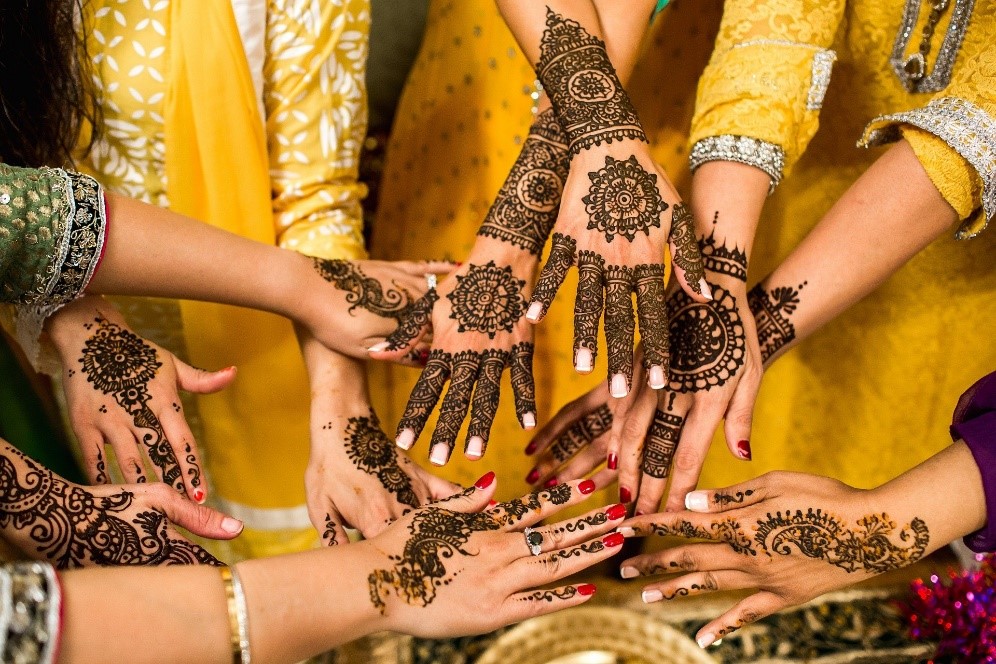
Henna – popularly known as mehendi
When people think of India and tattoos, they often connect it with henna. Henna is a semi-permanent tattoo that lasts for a couple of weeks. It is made using the paste of henna leaves. It is popularly referred to as Mehendi and is a treasured ritual in the Indian culture. Henna is a significant tradition in weddings, religious rituals, and other such events. The henna is generally applied to the hands and the feet. This custom is believed to have evolved from an age-old practice of the desert communities. They would apply Henna to keep themselves cool. But India has a diverse history of tattoos that goes beyond Henna. Home to a large number of communities and tribes, tattoos have held different meanings for different groups. It has been a symbol of beauty, status, class, caste, strength, faith, and even gender. Every tribe also has its own technique and tools for tattooing. The Apatani Tribe in Arunachal Pradesh, for example, used tattooing to make the women appear unappealing to the men from enemy villages. Some believe that this is a misinterpretation and that their tattooing reflected their beliefs, rituals, and bonds with nature. They use thorns to pierce the skin. The tattoo ink is a mixture of soot and animal fat. The men of the Konyak tribe of Nagaland wear tattoos as a symbol of tribe identity, manhood, even of their war victories, and headcount. The traditional tattooing tool is called a ‘Thongkoa’. It inserts the ink made of soot and leaf juice into the skin. The Rabaris community in Gujarat also has a revered tradition of tattooing. The women consider tattoos to be therapeutic as well as a symbol of identity and strength. Women of marriageable age are adorned with tattoos as naked skin is regarded to be unattractive. Men tattoo the backside of their right-hand palms with images/symbols of camels. The ink consists of lampblack, tannin, mother’s milk, or/and even urine.
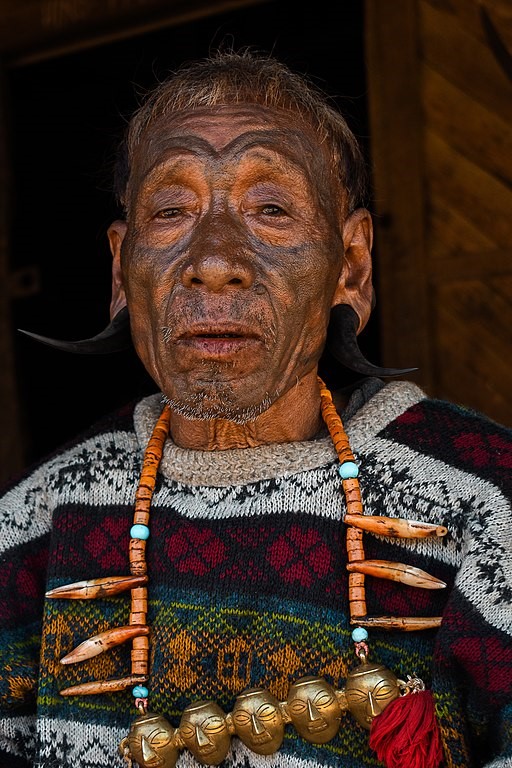
Traditional tattoo culture of the Konyak Tribe, Nagaland
Patterns: Some of the most common designs in Henna are peacock (beauty), vines and leaves (strength, longevity, devotion), and flowers (new beginnings, beauty, joy). Tribes have distinct patterns, designs, and symbols. For example, the Rabaris women tattoo symbols of snakes, scorpions, etc., while the men generally have a camel tattoo.
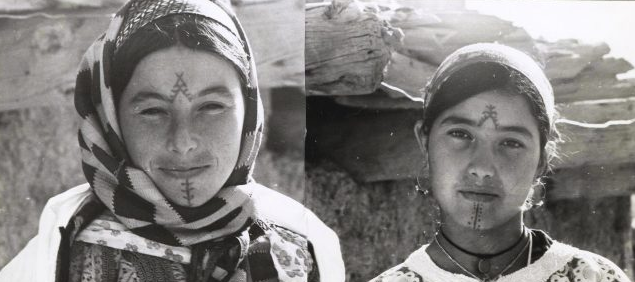
Traditional face tattoos on Amazigh women
Photo: Michael Peyron
The Amazigh or Berber tattoo culture in Morocco has had a rich past. Since the earliest times, Amazigh people had used tattoos as a symbol of identity, rooted in each group’s history and purpose. This culture has been unequivocally women based. Nonetheless, few men do have small and discreet tattoos. Amazigh women would wear tattoos as body ornaments seen no different than makeup. At the same time, tattoos would also represent the social and marital status of a woman. A woman’s tattoos would evolve with changes in her life. Women would get their first tattoo, a facial tattoo called Siyala for inducing fertility, on their chins. They would get various other tattoos for good health and warding off evil spirits. Puberty, marriage, loss of a spouse, were instances that called for tattoos. The tattoos were generally drawn near body openings such as the mouth, nose, eyes, and navel. The tattooist was generally a middle-aged woman. She would use needles, incense, aromatic herbs, black coal as well as a dye ink made of leaf juice for the tattooing. The growing Islamic culture in North Africa has been a major obstacle to their tattooing tradition.
Patterns: Some symbols used were trees (strength), snake (healing), bees (stamina), and diamond shapes (protection from evil).
Patterns: Some classic Chinese tattoo symbols are dragon (wisdom, goodwill, luck), phoenix (prosperity, rebirth, peace), Foo dog (good fortune, protection), Koi fish (power, perseverance), as well as the popular use of traditional Chinese characters. Dai people would commonly wear tattoos of dragons, tigers, etc.
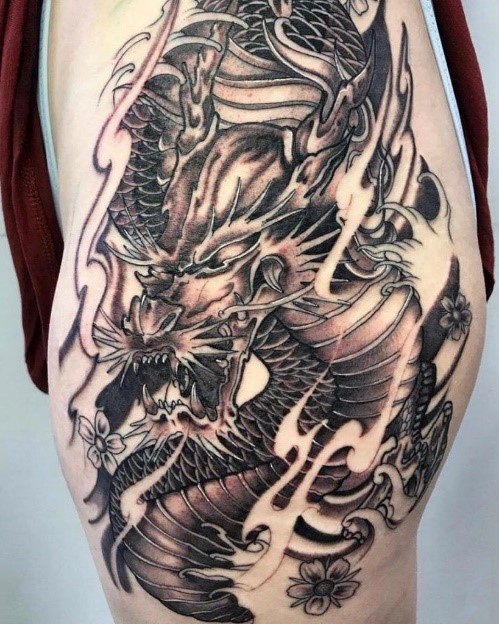
Traditional Chinese Dragon Tattoo
Via: @royalrosetattoo Instagram
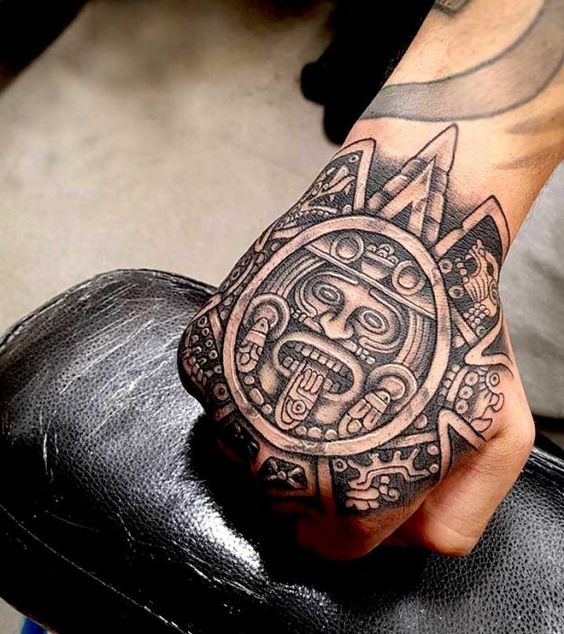
Traditional Aztec Tattoo Culture
Via: Pinterest
Patterns: The most common and sacred symbol is the sun. The Aztecs held the sun to be the source of all life. Animal tattoos were also common as they represented spirit guides. For example, eagles symbolized a powerful and dominating personality, tortoise reflected slowness, and monkeys were characteristic of erratic behavior.
No matter the cultural space, the culture of tattooing has always come down to perspectives. Some communities have seen the human body as a shrine that must not be ruined by any foreign element. But some communities have perceived the skin as a blank canvas, that’s waiting to be painted with a story. Each tattoo has something to say.
The word tattoo had originated from the Polynesian word ‘tatau’. After his first travel to New Zealand and Tahiti in 1771, Captain James Cook brought this word to Europe. He had seen there, men and women with huge tattoos all over their bodies. His fascination for their ‘tatau’ came back to the western world with him. But unlike the origin of this word, the art of tattooing is not a recent phenomenon. As mentioned above, tattoos are at least 5,200 years old. The earliest evidence of tattoos had been discovered on the mummified remains of Ötzi the Iceman. Discovered in the Oztal Alps in 1991, he had about 61 tattoos. Most of them were around his lower back and joints. There have also been discoveries of tattooed mummies in countries like Egypt, Sudan, and the Philippines.
Different countries and cultures have perceived tattoos in their own ways. Some of the most distinct and popular systems are:
Maori Tattoo | Ta Moko

Native to New Zealand, the Maori tribe has a rich culture of tattooing. It reflects a sense of pride, belonging, and identity. Their style is also very different from their Polynesian neighbors. In fact, contrary to conventional belief, not having tattoos is a rebellious act in the Maori tradition. Tattoos are considered sacred, representing a rite of passage for both men and women. Every design and symbol has a special meaning. Tattoos symbolize aspects like personal growth, ancestry, rank, individuality, life history, and achievements. The Maori tribe considers the face to be the most important and sacred part of the body. The Ta Moko represents the art of face tattoos. While men tattoo their whole faces, women tattoo their chin, lips, nostrils, and throat only. A woman’s chin tattoo is known as Moko Kuaue. Tattooing on any other part of the body is referred to as Kiri Tuhi. For boys and girls, getting tattooed would represent the transition to adulthood. Soldiers would often get tattoos to appear more dangerous to their enemies. Tattoos are also considered a beauty symbol, making the person more attractive. Getting Maori tattoos is a painful process. To make these tattoos, the tattoo artists puncture the skin using chisels. The whole process renders the person bedridden for days. This art suffered immensely under the colonial suppression of the 20th century. The 1970s witnessed a revival and restoration of this sacred tradition. Maori tattoos continue to hold the same essence and standing to date. For Maoris, tattoos will always be a precious taonga (treasure).
Maori Tattoo Patterns: The main outlines in the Maori tattoos, known as Manua, translates to ‘heart’. These lines represent a journey through life, achievements, and aspirations. Korus are spirals that represent aspects like harmony, growth, new beginnings, and loved ones. There are many other symbols like the Hei Matau (prosperity, good health), Pikorua (path of life, eternity), and Hei-tiki (ancestry).

Photo: Kina Sai
Samoa Tattoo | Pe’a, Malu
“Your necklace may break, the fau tree may burst, but my tattooing is indestructible. It is an everlasting gem that you will take into your grave”-A verse from a traditional tattoo artist’s song
Samoan or Polynesian tattoo culture has a legacy that dates back at least 2,000 years. Almost every individual in the community bears tattoos on their bodies. Tattoos are not seen merely as a body embellishment. They also represent a person’s position in society and their ancestry. It is a symbol of honor, strength, and virtue for Samoan culture. Warriors and chiefs tend to have the most extensive tattoo work. Male tattooing is known as Pe’a. Traditional Samoan males get tattooed from mid-torso to the knees with intricate designs. Women have tattoos that start from below the knees and go up to the upper thighs. Their tattoo style is known as Malu and is more delicate compared to Pe’a. The tattoo artists, known as tufuga, use tools made of sharpened boar teeth, turtle shells, and wood. The whole process is long and painful. There is also a risk of infection. After the work was complete, the tattoos would take a while to heal. The whole tribe would assist the person in his daily affairs until he was fit to do so himself. Despite the dangers, a man was called a coward if he did not go through the process. A ceremony would celebrate the end of this difficult yet fulfilling journey. The coming of Christian missionaries in the 19th century was a setback to this custom. Tattoos were seen as barbaric, and they tried to eradicate it. Samoan tattoo culture has managed to survive through this intrusion.

Via: @therock Instagram
Patterns: The symbols are based on the four elements- the ocean, earth, fire, and wind. Some of the commonly used symbols are Tiki (protection), turtle (fertility), dolphin (wisdom), Shark teeth (power, ferocity), and sun (brilliance, leadership).
Egypian Tattoos
Egyptian tattoos have had a long and intriguing past. The tattoos found on a male and female Gebelein mummy are in fact the earliest evidence of figurative tattoos. They belong to the same period as Otzi the Iceman. The next discovery is more than a millennium later only. Tattooing in ancient Egypt appears to be an exclusive practice among women. For a very long time, Egyptian history’s interpretation fell under the bias of male historians. They associated these female tattoos with low social standing. Women with tattoos were believed to have been ‘dancing girls’ or prostitutes. The discovery of tattoos on elite female mummies and a closer study of these symbols challenged this myth. The mummy of Amunet, a priestess of the goddess Hathor, displays a pattern of dots tattooed on her abdomen. Such patterns have been found on several other mummies and figurine dolls. This pattern was interpreted as a symbol of protection associated with childbirth. As the belly swells, the net-like pattern forms a protective barrier around the baby. The symbol of Bes (the god of childbirth and fertility, among other things) found tattooed on the upper thigh of these women backs this theory. Later designs also included hieroglyphs such as Nefer and the eye of Horus. Such tattoos were often found on the throat, shoulders, and back and were presumed to have religious symbolism. They used sharp metal points with wooden handles as a tattooing instrument. The ink used was a mixture of charcoal soot or indigo powder.Many Egyptians consider tattoos as a taboo in contemporary times. This has mostly to do with the present-day religious restrictions and government opposition in the country.

Via: tattoo.com
Patterns: Some of the most well-known symbols are: lotus flowers (life and rebirth), scarab beetle (mound of creation), the Ankh (key of life, a symbol of river Nile), cows (associated with goddess Hathor), Eye of Ra (restoring harmony), Egyptian Gods, etc.
Japanese Tattoos | Irezumi

Tattoos in Japan have had a very complicated history. Known as Irezumi, the Japanese art of tattooing can be traced back to the Jomon period (14,500 BC – 300 BC). Clay figurines called ‘dogus’ belonging to this era have been recovered with tattoo-like marks. According to Chinese records dating back to the 3rd century, Japanese men from different tribes bore many tattoos on their faces and bodies. This ancient art form held different meanings – as a decorative body art, representation of spiritual and religious beliefs, as well as a status symbol that varied with rank. The relevance of tattoos has fluctuated in the Japanese society since then. By 720 AD, forehead tattoos explicitly became a device of criminal punishment. The Edo Period (1603-1868) then brought about the golden age of tattooing. The growth of woodblock printing, known as ukiyo-e had popularised folklore heroes. Their images were now being tattooed on bodies. It is during this phase that Irezumi flourished and grew as an art. Irezumi tattooing is a long and painful process. The traditional technique of tattooing by hand is tebori. They use chisels and gouges, which are needles bound to a metal or a wooden stick. They also use a special type of ink known as Nara Ink. The rulers tried to ban tattoos around this time. The Japanese government reused tattoos as a form of punishment, known as bokkeii. Prisoners would be branded with tattoos, making it difficult for them to re-enter society. The Yakuza, a criminal gang, started using full-body tattoos as a symbol of protest. It soon became a rite of passage for every new member. Ultimately, the government outlawed tattooing. It was legalized only after the American occupation in 1948. By then, a stigma around tattoos had already settled in the society. Even now, tattoos are looked down upon. Several public places, like saunas, gyms, and pools, have a strict no-tattoo policy.

Patterns: Some of the most popular motifs are Koi fish (luck, good fortune), sakura or cherry blossoms (transience), Ryu or dragon (wisdom, patience, creativity), tiger (strength, ferocity, protection).
Thailand Tattoos | Sak Yant

Via: thestyleup.com
The traditional Thai art of tattooing is known as Sak Yant. Literally, ‘Sak’ means ‘to tap’ or ‘to tattoo’, while Yant comes from the Sanskrit word ‘Yantra’ which refers to a machine/apparatus. The intricate geometric designs make the tattoos look aesthetic. Such tattoos are seen as no ordinary creations. The symbols, prayers, and scriptures that are tattooed carry a religious and spiritual message. These tattoos are believed to be magical and sacred. Only monks and ajarns who undergo rigorous training to learn this sacred art can create these tattoos. Sak Yant tattoos had originated from the Khmer people. Asian religions, especially Buddhism and Hinduism, have moulded this tradition over time. Each work holds a special meaning that is unique to the wearer. It is a holy belief that these tattoos would bring them luck, strength, and healing and protective powers. Warriors would often get Sak Yant tattoos for strength and protection against their enemies. The Sak Yant Master chants a final blessing to activate the magical powers of the tattoo. The traditional style of stick-poke tattooing is still prevalent in this tattoo culture. They use a metal or a bamboo stick with a needle attached to the top. The ink is a mixture of elements like charcoal soot, sesame oil, or/and even snake venom. It is then hand tapped into the body. Another important aspect of this culture is the Buddhist moral code attached to this process. A person who gets the Sak Yant is expected to follow certain principles for life (for example, to never lie, kill, steal, etc.). This code of conduct is regarded as the foundation for a life of simplicity and righteousness.
Patterns: Some of the most well-known designs are:
-Hah Taew or Five Sacred Lines (good luck, protection, kindness, charisma),
-Paed Tidt or Eight Directions (protection wherever you travel),
-Gao Yords or Nine Peaks (universal powers, dedication, the path to enlightenment).
India | Henna and beyond

When people think of India and tattoos, they often connect it with henna. Henna is a semi-permanent tattoo that lasts for a couple of weeks. It is made using the paste of henna leaves. It is popularly referred to as Mehendi and is a treasured ritual in the Indian culture. Henna is a significant tradition in weddings, religious rituals, and other such events. The henna is generally applied to the hands and the feet. This custom is believed to have evolved from an age-old practice of the desert communities. They would apply Henna to keep themselves cool. But India has a diverse history of tattoos that goes beyond Henna. Home to a large number of communities and tribes, tattoos have held different meanings for different groups. It has been a symbol of beauty, status, class, caste, strength, faith, and even gender. Every tribe also has its own technique and tools for tattooing. The Apatani Tribe in Arunachal Pradesh, for example, used tattooing to make the women appear unappealing to the men from enemy villages. Some believe that this is a misinterpretation and that their tattooing reflected their beliefs, rituals, and bonds with nature. They use thorns to pierce the skin. The tattoo ink is a mixture of soot and animal fat. The men of the Konyak tribe of Nagaland wear tattoos as a symbol of tribe identity, manhood, even of their war victories, and headcount. The traditional tattooing tool is called a ‘Thongkoa’. It inserts the ink made of soot and leaf juice into the skin. The Rabaris community in Gujarat also has a revered tradition of tattooing. The women consider tattoos to be therapeutic as well as a symbol of identity and strength. Women of marriageable age are adorned with tattoos as naked skin is regarded to be unattractive. Men tattoo the backside of their right-hand palms with images/symbols of camels. The ink consists of lampblack, tannin, mother’s milk, or/and even urine.

Patterns: Some of the most common designs in Henna are peacock (beauty), vines and leaves (strength, longevity, devotion), and flowers (new beginnings, beauty, joy). Tribes have distinct patterns, designs, and symbols. For example, the Rabaris women tattoo symbols of snakes, scorpions, etc., while the men generally have a camel tattoo.
Morocco | Berber Tattoos

Photo: Michael Peyron
The Amazigh or Berber tattoo culture in Morocco has had a rich past. Since the earliest times, Amazigh people had used tattoos as a symbol of identity, rooted in each group’s history and purpose. This culture has been unequivocally women based. Nonetheless, few men do have small and discreet tattoos. Amazigh women would wear tattoos as body ornaments seen no different than makeup. At the same time, tattoos would also represent the social and marital status of a woman. A woman’s tattoos would evolve with changes in her life. Women would get their first tattoo, a facial tattoo called Siyala for inducing fertility, on their chins. They would get various other tattoos for good health and warding off evil spirits. Puberty, marriage, loss of a spouse, were instances that called for tattoos. The tattoos were generally drawn near body openings such as the mouth, nose, eyes, and navel. The tattooist was generally a middle-aged woman. She would use needles, incense, aromatic herbs, black coal as well as a dye ink made of leaf juice for the tattooing. The growing Islamic culture in North Africa has been a major obstacle to their tattooing tradition.
Patterns: Some symbols used were trees (strength), snake (healing), bees (stamina), and diamond shapes (protection from evil).
Chinese Tattoos | Wen Shen
The tattoo culture of China has a long and unpopular past. The Chinese art of tattooing is known as Wen Shen or Ci Shen, which translates to ‘puncturing the body’. In China, tattoos have been in existence since the sixth century. Despite this, most have seen tattoos as a distasteful practice, a form of body disfiguration. One of the four classical novels of Chinese literature, Water Margin, also weaves a tale of 12th-century bandits wearing tattoos. Like the Japanese, tattoos came to be used by Chinese rulers to mark convicts. During the Han Dynasty, 500 forms of crime had tattoo punishments referred to as mo zui (‘ink crimes’). There are a few minority tribes that have unique tattoo traditions. The women of the Dulong tribe would get face tattoos to make them uglier so that the men from enemy tribes would not rape them or take them away. And although such fears no longer exist, it has become a tradition and a rite of passage for all Dulong women. In the Dai community, both men and women get tattoos. For men, it is a symbol of strength and masculinity. The Li people of Hainan Island also have a tradition of tattooing. They observe this as a mark of maturity and adulthood. Tattooing is more prevalent among Li women. The mainstream outlook, nonetheless, continues to be conservative. Even now, the Chinese tend to associate tattoos with criminal backgrounds. The Chinese government has banned the appearance of tattoos in all forms of media. Despite the age-old prejudice against tattoos, Chinese youth is embracing the tattoo culture.Patterns: Some classic Chinese tattoo symbols are dragon (wisdom, goodwill, luck), phoenix (prosperity, rebirth, peace), Foo dog (good fortune, protection), Koi fish (power, perseverance), as well as the popular use of traditional Chinese characters. Dai people would commonly wear tattoos of dragons, tigers, etc.

Via: @royalrosetattoo Instagram
Mexico | Aztec Tattoo Culture
The Aztec Civilization flourished between the 13th and 16th centuries in central Mexico. It left the world with, among many other things, a unique and fascinating tattoo culture. They took pride in their alluring and detailed designs that were way more advanced compared to their contemporaries. Tattoos formed a crucial part of Aztec rituals. For example, children would be tattooed with symbols of deities whose qualities they aim to embrace and cultivate in their lives. The location of such a tattoo would also hold a symbolic meaning. Tattoos were also badges of honor for the Aztec warriors. Aztec tattoos reflect their people’s pride in their cultural and civilizational roots. It continues to influence Mexico’s modern tattoo culture.
Traditional Aztec Tattoo Culture
Via: Pinterest
Patterns: The most common and sacred symbol is the sun. The Aztecs held the sun to be the source of all life. Animal tattoos were also common as they represented spirit guides. For example, eagles symbolized a powerful and dominating personality, tortoise reflected slowness, and monkeys were characteristic of erratic behavior.
No matter the cultural space, the culture of tattooing has always come down to perspectives. Some communities have seen the human body as a shrine that must not be ruined by any foreign element. But some communities have perceived the skin as a blank canvas, that’s waiting to be painted with a story. Each tattoo has something to say.

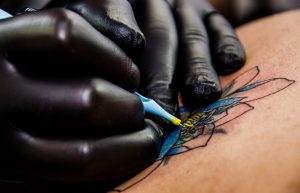

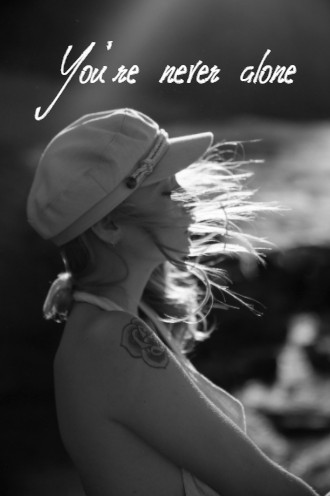
Very interesting and unique article. Thank you for all the in-depth research that you did.